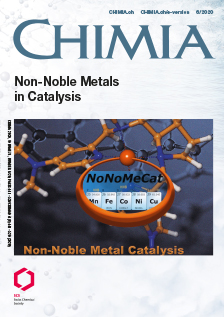A Diiron Hydrogenase Mimic Featuring a 1,2,3-Triazolylidene
DOI:
https://doi.org/10.2533/chimia.2020.499PMID:
32560757Keywords:
Bioinspired model, Diiron complex, Hydrogenase, Mesoionic carbene, Proton reductionAbstract
A novel complex featuring a mesoionic carbene [Fe2(CO)5(trz)(μ-pdt)] (1) (trz = 1-phenyl-l,3-methyl,4-butyl-1,2,3-triazol-5-ylidene), was synthesized and spectroscopically and structurally characterized. The reductive behaviour of this compound in the presence and in the absence of acid (CH3CO2H) was examined by cyclic voltammetry (CV) that revealed the lack of efficient activity towards proton reduction.
Downloads
Published
2020-06-24
How to Cite
[1]
A. Mele, S. Bertini, M. Albrecht, C. Elleouet, F. Y. Pétillon, P. Schollhammer, Chimia 2020, 74, 499, DOI: 10.2533/chimia.2020.499.
Issue
Section
Scientific Articles
License
Copyright (c) 2020 Andrea Mele, Simone Bertini, Martin Albrecht, Catherine Elleouet, François Y. Pétillon, Philippe Schollhammer

This work is licensed under a Creative Commons Attribution-NonCommercial 4.0 International License.







